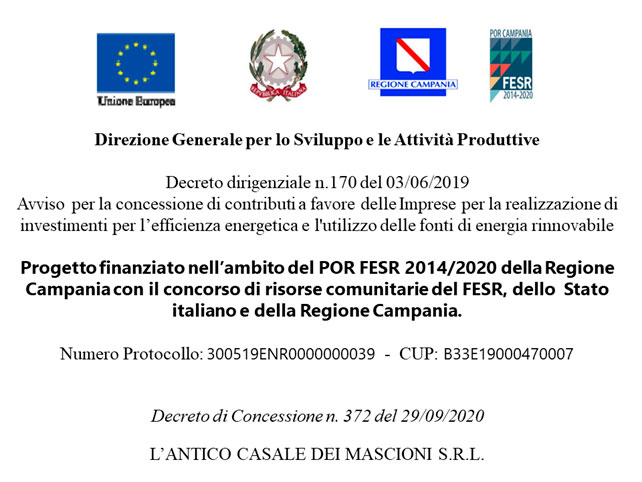
The energy efficiency project implemented by L’ANTICO CASALE DEI MASCIONI LIMITED LIABILITY COMPANY consists of three fundamental interventions for sustainable development:
The energy efficiency project involved the construction of a photovoltaic system on a slightly sloping roof with a nominal power of 38 kWp grid-connected, in self-consumption regime through the activation of the Exchange on the Post (SSP) service, i.e. a particular form on-site self-consumption which makes it possible to offset the electricity produced and fed into the grid at a certain time with that withdrawn and consumed at a different time from that in which production takes place.
The connection is foreseen in medium voltage 20 kVac with dc/ac conversion groups distributed and connected in parallel and the electrical conversion is distributed autonomously so as to minimize the correlation effects due to mismatching.
The specific producibility is calculated as approximately 1,300 kWh/kWp/year, net of machine efficiency and the performance drop expected from the technology used, in relation to the specific installation conditions, on roofs and with variable inclinations.
Through the construction of the photovoltaic system, L’ANTICO CASALE DEI MASCIONI S.R.L. has pursued the main objective of achieving a reality based on the concept of environmental sustainability. In fact, to produce one kilowatt-hour of electricity the equivalent of 2.56 kWh is burned on average in the form of fossil fuels and consequently about 0.301 kg of carbon dioxide are emitted into the air; it can therefore be stated that each kWh produced by the photovoltaic system avoids the emission of 0.301 kg of carbon dioxide.
The “electricity mix emission factor” represents the average value of CO2 equivalent emissions due to the production of electricity used in Italy. The data, updated to date, is made public by ISPRA and is equal to 0.301 kg of CO2EQ/kWh.
| Fattore di emissione mix elettrico | Risparmio annuale di emissioni CO2EQ [Kg] | I – Investimento [€] | Risparmio annuale CO2EQ/I [kg CO2EQ/€] |
| 0,301 kg CO2EQ/kWh | 14.869 | 52.000 | 0,286 |
It should also be remembered that the Legislative Decree 102/14 on energy audits defines UNI CEI EN 16247 as the reference regulatory standard, which requires the auditor to collect measured and disaggregated consumption data by process. Therefore, the analytical approach partially used for the drafting of this DE and permitted by Legislative Decree 102/14 only for the first energy diagnosis.
At the technical implementation level, the installation of dedicated measuring instruments with semi-direct insertion MID certification is envisaged on site, as well as gateways for the collection of recorded data and data loggers for transferring them to the Web Server Cloud remote platform, for the functional areas identified according to the UNI CEI EN 16247 Standards and Annex II of Legislative Decree 102/2014.
The coverage of instrumentation, control and management systems is developed so that the energy parameters relating to the successive DEs can have increasing reliability with the progressive implementation of these systems.
The remote management platform integrates the control of the various types of systems present in the Company (thermoregulation, automation, production and distribution of energy from renewable sources) guaranteeing energy optimization criteria for the production process.
In particular, the supervision of the system covers the mechanical systems, HVAC thermoregulation, electrical systems (lights and windows), lighting and fire protection, energy consumption control up to safety systems and exodus management, effectively and efficiently . The reduction in consumption is estimated to be at least 10% compared to the current energy requirement.
Furthermore, the remote management platform, through the representation and analysis of the measured data, allows to quantify the actual energy savings achieved and to verify them in relation to the specific adjustment factors (destinations of use) established for the specific company activity .
INTERVENTION 3: Replacement of building envelope components: fixtures and insulation on the roof
The proposed intervention concerns:
– the replacement of the fixtures and related external doors and windows with external fixtures and doors to improve the thermal insulation of the building;
– the replacement of a significant part of the external coverings for the Catering Area with high performance coverings with thermal insulation of the building, with performance requirements characterized by low thermal transmittance.
The performance requirements of the external fixtures guarantee levels of low thermal transmittance thanks to the choice of thermal break profiles and low-emission double glazing.
Features of the windows and doors BEFORE INTERVENTION:
| Type of frame existing before the intervention | Type of glass existing before the intervention | Total surface area of frame and glass object of the intervention [mq] |
| Metal, no thermal break | Single | 370 |
Features of the POST-INTERVENTION windows and doors:
| Type of existing frame after the intervention |
Type of glass existing after the intervention |
Thermal transmittance of the new window [W/m2*K] |
| ALUMINUM | Low emission double glass | 1,2 |
The intervention generates a Primary Energy Saving estimated at 3.56 toe/year with a consequent economic saving estimated at €4,210/year.